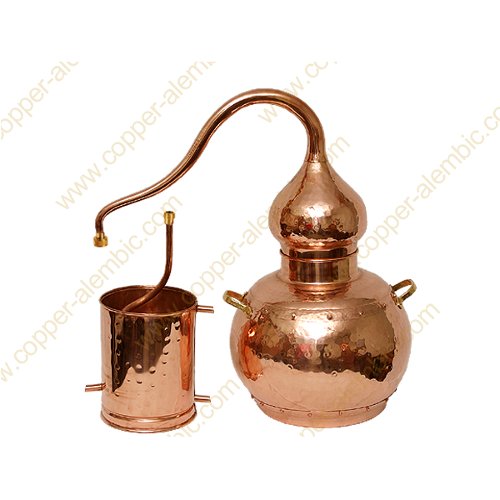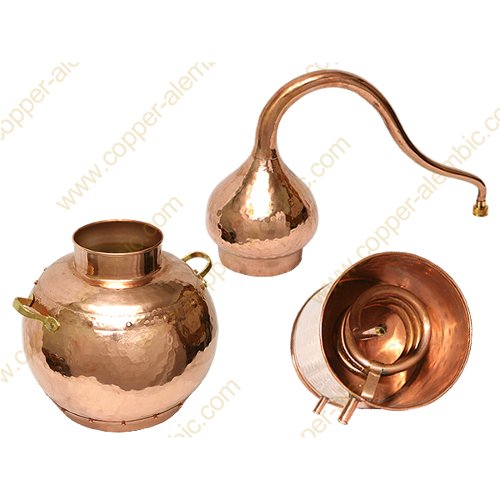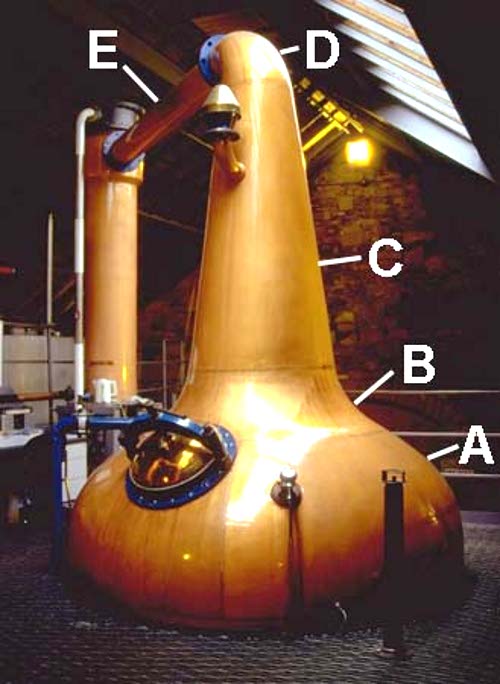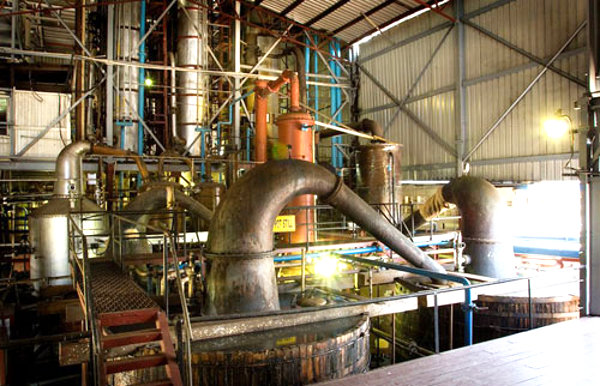Port Mourant: alleged "wooden double pot still"
Versailles: alleged "single wooden pot still"
One of the great marketing successes in rum history has been the DDL campaign which promotes the amazing, life-extending qualities of their "200 year old wooden pot stills" that magically transfer the essence of two centuries of distilling into your bottle of this ostensibly historical elixir. A typical claim? Try this claim on for size: "...adds complexity and richness to the spirit – this is due mainly to the residue of previous distillations that is left ingrained in the wood, which adds character to the spirit vapour as it passes through the still. ".
This is absolute mooseshit. Let's take this on, step-by-step...
Step One: "200 year old wooden pot stills"
Not. Are these wooden stills really 200 years old? In a word, no. The wood is replaced (as I recall) at the rate of about 10% per year. Thus the average age of these hallowed pot stills is about 10 years.
Step Two: "containing the residues of past distillations"
More monkey droppings. First of all - and as da'rum will confirm - the "residues" of distillations are really pretty awful, nasty stuff. In Scotland many of the truly authentic, and truly old copper pot stills are equipped with rotating lengths of chain designed to prevent a build-up of nasty residue. One of the big issues is actually to remove this leftover crap so as to improve the next distillation. If this "residue" was so tasty, they wouldn't work so hard to remove it.
Second: these wooden stills are NOT made of what you'd like to believe they are: namely, wonderful oak. Nope. Instead they are made of what's called "Greenheart" wood. It is most assuredly NOT oak. Instead it's a very hard type of evergreen as I recall that - unlike oak - is noted for being non-absorbant, extremely hard, water and fungus proof. Unlike oak it doesn't breathe, doesn't leak and is most frequently used for docks and wooden pilings in salt water environments. To believe that it's just chock full of wonderful tasty rum extracts is a fackin lie, to be kind.
Step three: "...classic pot stills made of wood"
Do you know what a real and classic pot still is? I do. Da'rum does. And so do untold thousands of home distillers and all of the old moonshiners. Let's not forget the alembics used for hundreds of years in the Mediterranean. Here's one:
 ..
..
A true pot still is very simple: a "pot" to boil off the alcohols, a "lyne arm" to carry the alcohol vapors away, and a condenser, in this case a classic "worm" - a spiral of copper tubing that transmits the vapor through a container filled with cold/cool water which condenses the vapor. The master distiller smells and tastes the output with the goal of capturing the "hearts" - the good stuff - from the run, disposing of the nasty head and tails that precede and follow the hearts.
Simple.
So how about the "200 year old wooden" pot still? How does it work? Not the same at all. In actuality, whether you're talking about either the single or double wooden set ups, the wooden part amounts to a boiler which then passes through a copper lyne arm to retort for a second distillation, and then to a - heaven help me - a single column called a "rectifier", which is nothing more than the 2nd column in a two-column Coffey still, designed for continuous output at very high (thin) alcohol. From the column, the vapors finally arrive at a condenser.
The DDL "pot stills" are not pot stills as they have promoted them, or as we know or believe.
They are really nothing more than hard wood, non-absorbant Greenheart tanks that are heated to - in the case of the single "wooden pot still" to act as simple boiler, and in the case of the "double wooden pot still" to act as a boiler and high output wash or stripping still. In both cases the real distillation is done by a combination of the retort and the rectifying column still. Yet how many people who get woodies over these so-called "200 year old wooden pot stills"?
Almost everyone, a real shame. Yet this remains a key and major selling point Typical marketing drivel. And I should add that even 200 years ago, the real pot stillers much preferred copper for producing a far superior spirit (removes sulfer, et al). Wooden stills were only used by distillers who could not afford expensive copper and were considered second rate even then.
Flat Ass Bottom Line
The DDL's "200 year old wooden pot stills" are true only in the sense that the boilers are indeed made of wood.. They are not operated as pot stills or alembics as we know them. They are not 200 years old. They are not made of oak, but of a local waterproof wood normally used to build docks. They use a complex system of distillation that requires retorts and a single, tall rectifying column to do most of the actual distillation.
In sum, DDL makes no authentic pot-stilled rums. And don't forget that even their worn-out columns are soon to be replaced by a new modern, high output column set up. Live with it.
Great marketing though...


